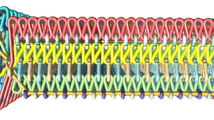Abstract
3D fabrics are in various forms and shapes and are used in different applications of technical textiles. The functional purpose of their use is primarily to create a barrier or maintain a distance between two mediums. Fabrics from knitting or weaving machines are mostly not in their end product shape. They have to be joined with different forms of joining methods, mostly sewing to obtain its final form. Usually the conventional method of sewing compresses the 3D fabrics at points of needle insertion and the fabrics do not perform along stitch line as they perform in rest of their plane. Spacer stitching is a new joining method developed, which particularly addresses the problems related to compressions along stitch lines. Spacer stitching samples are tested with skin model and the thermal resistance along stitch line are compared with conventional lockstitch sewing method. With the help of infrared technology, thermal emissions have been studied for spacer stitching and conventional lockstitch, compared and presented in this paper.









Similar content being viewed by others
References
Vogt, J.J., Meyer, J.P., Candas, V., Libert, J.P., Sagot, J.C.: Pumping effects on thermal insulation of clothing worn by human subjects. Ergonomics. 26(10), 963–974 (1983)
Stanković, S.B., Popović, D., Poparić, G.B.: Thermal properties of textile fabrics made of natural and regenerated cellulose fibers. Polym. Test. 27(1), 41–48 (2008)
Moriarty, C.: Thermal insulation structure and producrs made therefrom. US 2013/0177731 A1 (2013)
Daiber, O.C.: Insulated structure. US 2464380 (1949)
Farnworth, B.: Mechansim of heat flow through clothing insulation. Text. Res. J. 53(12), 717–725 (1983)
Reuben, R.: Down-fill quilted fabric with combination stitched lines and tach stitches. US 5799600 (1998)
William, S., Rice, E.: Dual insulation garment. US 5713079 (1998)
Mecheels, J.: Körper-Klima-Kleidung: Wie funktioniert unsere Kleidung? pp. 15–48. Schiele und Schön, Berlin (1998)
Adidas, A.G.: FW14 Apparel General Technology Guide. Adidas Outdoor. [Online]. Available: http://outdooragron.weebly.com/uploads/9/7/6/7/9767847/fw14_apparel_tech_guide.pdf. [Accessed: 05-Oct-2016]
Sellers, B., Usher, H.G., Kay, W.L.: Sleeping quilt. US 3837021 (1974)
Jerald, W.N.: Insulated sleeping bag. US 4910055, (1990)
Tesch, G.: Quilted bed blanket. US 5187825 (1993)
Maud, T.: Wärmeisolationsstruktur für ein Bekleidungsstück. DE 102014200824A1 (2015)
Saeed, H., Rödel, H., Krzywinski, S., Hes, L.: ‘Spacer stitching’, an innovative material feeding technology for improved thermal resistance. IOP Conf. Ser. Mater. Sci. Eng. 254, 132004 (2017)
H. Eberle, E. Gonser, and M. Schuck, Fachmathematik Bekleidung. 1988
Saeed, H., Krzywinski, F.: Sewing device, method for producing a sewn multliyaer structure and sewn multilayer structure. In: EP 3252196 (A1) (2017)
Sable, H.: Trailspace outdoor gear reviews. 2011. [Online]. Available: http://www.trailspace.com/articles/sleeping-bag-construction-baffles-shingles.html. [Accessed: 12-Mar-2016]
Pittsford, R.B.: Uncompacted filler batts. US 3278954 (1966)
Hes, L.: Permetest Manual. 2017. [Online]. Available: http://www.sensora.eu/PermetestManual09.pdf. [Accessed: 15-May-2017]
ISO 11092:2014 Textiles - Physiological effects - Measurement of thermal and water-vapour resistance under steady-state conditions (sweating guarded-hotplate test) (2014)
Hes, L.: Non-destructive determination of comfort parameters during marketing of functional garments and clothing. Indian J. Fibre Text. Res. 33(3), 239–245 (2008)
Hes, L.: Friendly testing of comfort parameters of functional garments and clothing and its use in marketing
Wissler, E.H., Havenith, G.: A simple theoretical model of heat and moisture transport in multi-layer garments in cool ambient air. Eur. J. Appl. Physiol. 105(5), 797–808 (2009)
Author information
Authors and Affiliations
Corresponding author
Rights and permissions
About this article
Cite this article
Saeed, H., Rödel, H., Krzywinski, S. et al. A New Stitching Technology for Improved Thermal Insulation of 3D Nowoven Assemblies. Appl Compos Mater 26, 409–421 (2019). https://doi.org/10.1007/s10443-018-9738-5
Received:
Accepted:
Published:
Issue Date:
DOI: https://doi.org/10.1007/s10443-018-9738-5




